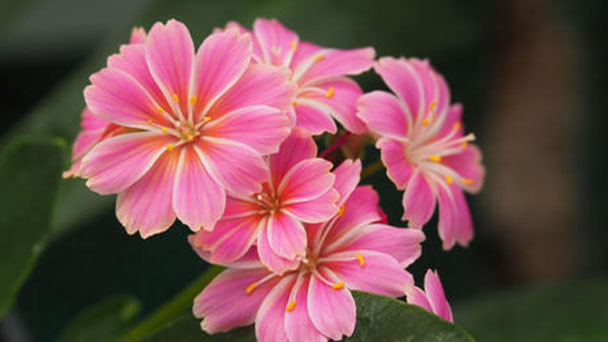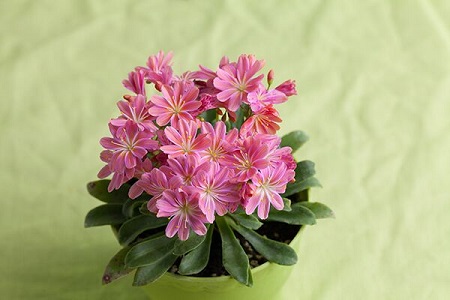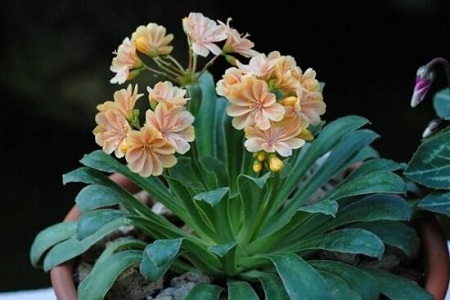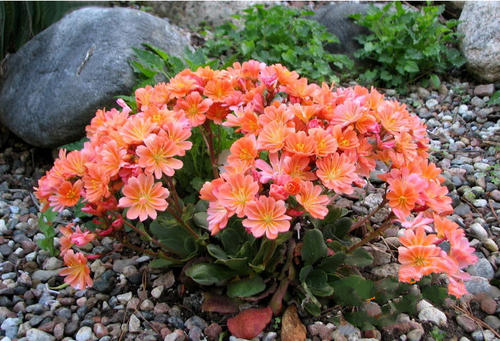Lewisia cotyledon (Siskiyou Lewisia) profile
Written by Maggie
Mar 18 2021

Lewisia cotyledon, also called Siskiyou lewisia and cliff maids, belongs to the Portulaca family; Lewisia cotyledon, native to the mountains of the central west coast of the United States. Flowers are white, flowering from early spring to summer. Roots are fleshy, leaves obovate. Lewisia cotyledon cold resistance is not strong. Lewisia cotyledon likes spring wet, summer dry environment.
Lewisia cotyledon picture
Morphological characteristics of Lewisia cotyledon
Roots fleshy basal rosette of Lewisia cotyledon, 10 -- 12cm in diameter, leaves obovate-spatulate, 7.5cm long, entire or undulate. Panicles are terminal, ca. 25cm tall. Flowers white with red veins, red flecks, or red stripes, petals 8-10, spreading, 1.2cm long.
Lewisia cotyledon flowers from early spring to summer.
Ecological habits of the Lewisia cotyledon
Lewisia Cotyledon should be exposed to full sunlight in humid areas. Cold resistance is not strong. lewisia cotyledon likes spring wet, summer dry environment. It should be well-drained, deep and easy with gravel soil. lewisia cotyledon likes half shade, but in humid climate areas, appropriate light. Lewisia cotyledon is suitable for rich, deep sandy soils.
Lewisia Cotyledon avoids drought and is not tolerant of extreme heat.
The way Lewisia cotyledon propagates
Propagation method of Lewisia cotyledon: Sowing propagation or dividing plants in spring.
Sow propagation
Water quality should be clean, water containers should not be stained with oil, salt, acid, alkali, herbicide and other harmful substances. When the soil temperature is very low in winter, warm water can be poured appropriately.
Division propagation
To form small plantlets on the mother plant. The method of separating small plants and planting them separately is called multiplication by division. This method is simple, the survival rate is high, but the reproduction coefficient is low, often used for the propagation of the fine single plant.
How to grow and care for Lewisia Cotyledon
1. Soil care
The soils of Lewisia Cotyledon are usually acidic and must be well drained.
2. Lighting care
If you are in a humid climate, Lewisia Cotyledon can be full light, of course, in the summer light is very strong circumstances or appropriate shade.
3. Watering care
Watering has a heavy impact on the growth of Lewisia Cotyledon, especially in summer high-temperature weather, the growth rate of Lewisia Cotyledon is slow, at this time to reduce watering, keep the potting soil dry, so as to avoid root rot.
4. Fertilization care
Lewisia cotyledon flowers more often and requires more nutrients. Since May, the growth rate of Lewisia cotyledon increases, so it needs to be applied with thin nitrogen every two months. In summer, Lewisia Cotyledon will slowly bud, fertilizer should be based on phosphate, half a month.
5. Pruning and shaping care
The Lewisia cotyledon has lotus-shaped flowers with many stems drawn from the center of the leaves. To flower in the second year of Lewisia Cotyledon, cut off the flower stem in time after flowering, and pruned the branches and leaves appropriately, and cut off the overdense growth to add the light transmittance of the plant.
6. Winter and summer care
Lewisia cotyledon has poor cold resistance and heat resistance, so we should pay attention to transplant it indoors in winter and take insulation measures.
Summer to avoid sun exposure can be placed in a better-ventilated place to maintain.

Disease control of Lewisia Cotyledon
When winter comes, Lewisia Cotyledon is not very hardy. Insects and diseases of flowers will gradually enter the overwintering state. During this period, all kinds of diseases and insects are basically inactive and have little mobility, which is a good season for prevention and control. Practice has proved that if the prevention and control measures in winter are effective, the occurrence and harmful degree of diseases and insects in the coming year can be greatly reduced and the effect of getting twice the result with half the effort can be obtained.
The pathogens (bacteria) or overwintering eggs of most flower diseases and insects in the garden overwinter in the dead leaves and weeds of the garden and come out in the coming year when the conditions are suitable. Therefore, in winter, the dead leaves and weeds in the garden completely removed and destroyed, improve the health situation, can greatly reduce the source of various diseases and insects. This has a remarkable effect on the prevention and control of diseases and insects.
Winter pruning is an important part of the management of Lewisia Cotyledon. Combined with winter pruning, focus on cutting off branches and leaves carrying insects. Insect eggs cut the insect branches and leaves should be cleaned up in time, and transported out of the concentrated treatment outside the nursery.
The deep turning of winter tillage can cause mechanical damage to the larvae, pupae and eggs of underground pests such as grubs, ground worms, mole crickets and gold needles, which can be pecked at by natural enemies such as birds after being exposed to the surface and can also be killed artificially if necessary.
Species taxonomy of Lewisia cotyledon
The Lewisia Cotyledon pattern is also very rich: red, pink, mauve, white, yellow, orange, salmon red and many other stripes.
The distribution of Lewisia cotyledon
Lewisia Cotyledon is a native of the mountains of the Central West Coast of the United States.
Chiefly mountainous areas of northern California and southern Oregon, growing on steep rocky slopes and in vertical crevices of the rock. In recent years, rock gardens featuring alpine plants have become popular among gardeners.
Uses of Lewisia Cotyledon
Ornamental effect
Lewisia cotyledon flowers from early spring to summer, but some species bloom again in autumn. Even when not in flower, the plant is very beautiful in shape, with basal rosettes and dark green leaves spreading from the inside out in an obovate-spatulate, entire or undulating shape.
Potted value
Lewisia Cotyledon is well suited to rich, thick sandy soils. To propagate by sowing or dividing in the spring. Lewisia cotyledon is used for rock gardens, popular in recent years for potted plants.

Latest Updated
- Benefits of Bugleweed - 7 Science-backed Health Benefits
- Bugleweed Dangers & Side Effects - Is It Poisonous?
- How to Plant Evergreen Trees - What You Should Know
- When to Plant Evergreens - Grow Guide for Evergreen Trees
- 12 Wonderful Evergreen Shrubs for Your Garden
- 12 Popular Evergreen Plants with Pictures for Beginners
- When And How To Prune A Lilac Bush Like a Pro
- How to Grow & Care for Lilac Vine (Hardenbergia Violacea)
- Japanese Lilac Tree (Syringa Reticulata) Care & Propagation Guide
- Shumard Oak Pros and Cons - What to Know
Popular Articles
- Winter maintenance of Antirrhinum Majus
- How to Grow Terminalia Mantaly Tree
- How to Grow and Care for Crossostephium Chinense
- How to grow Antirrhinum Majus in spring
- Peristeria Elata (Dove Orchid) Profile: Info & Care Guide
- Underwatered Snake Plant (Sansevieria Trifasciata) - Signs And How To Fix
- How to Care for Brazilian Jasmine Plant (Mandevilla Sanderi)
- How to Grow & Care for Graptopetalum Purple Delight in Summer
- Rosa Chinensis (China Rose): Plant Growing & Care Tips
- How to Care for Baby Sun Rose (Aptenia Cordifolia)
